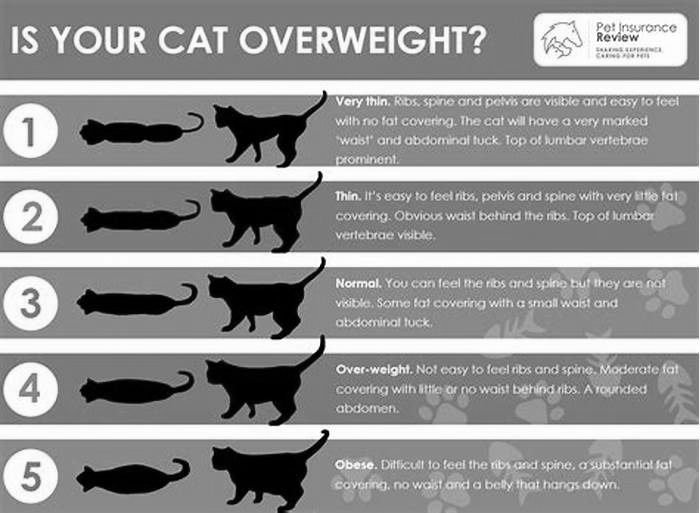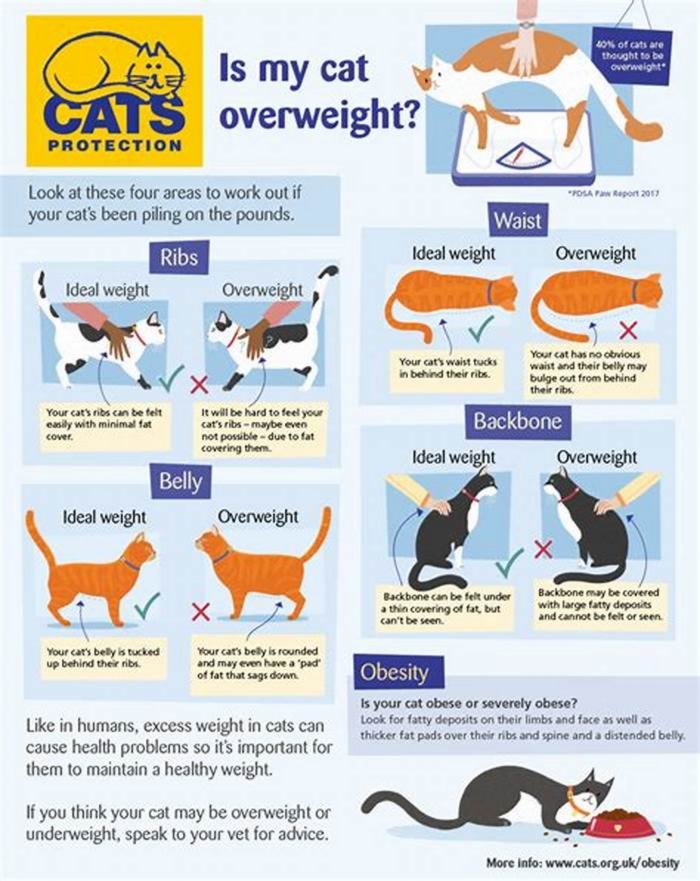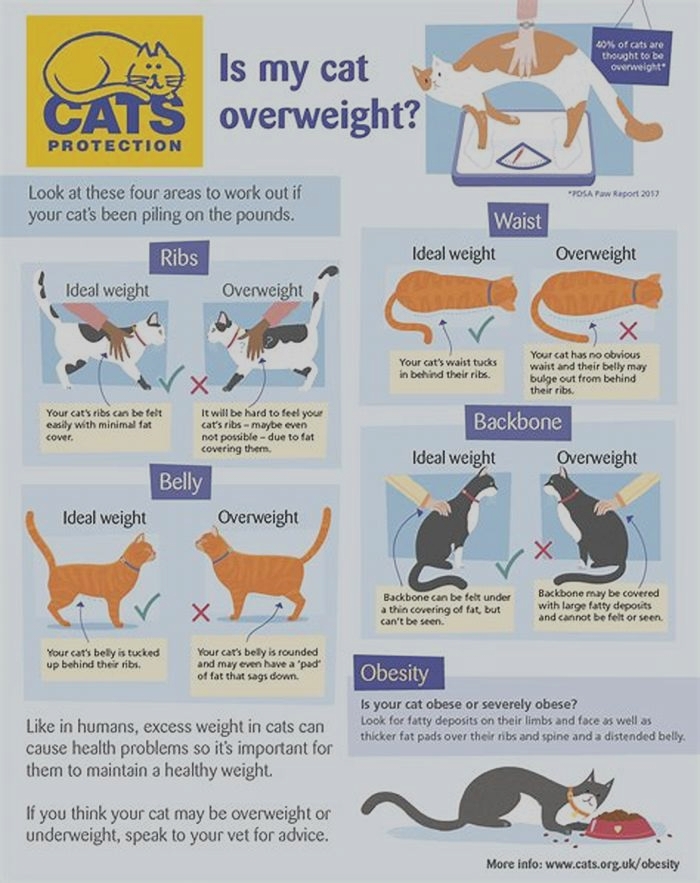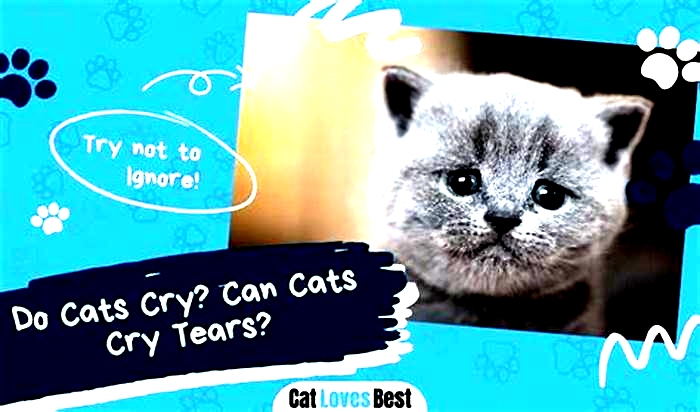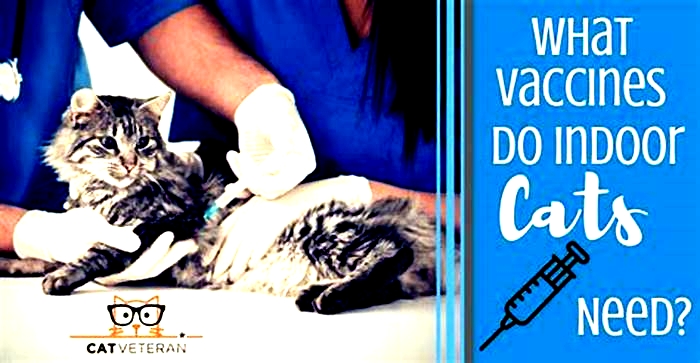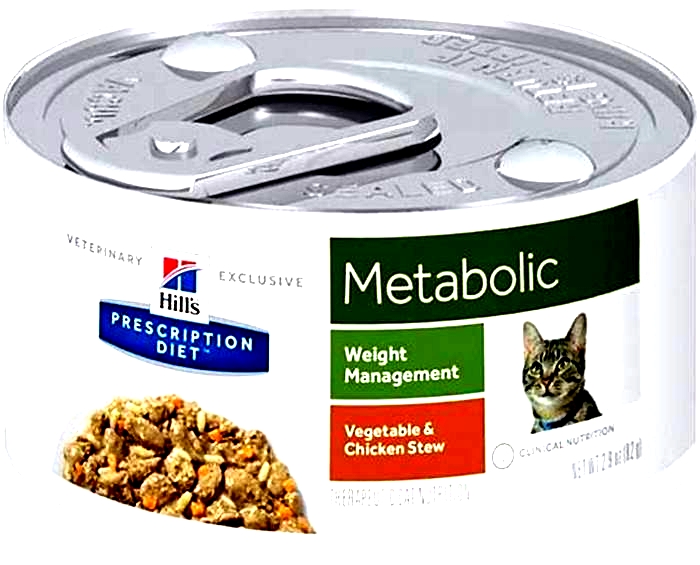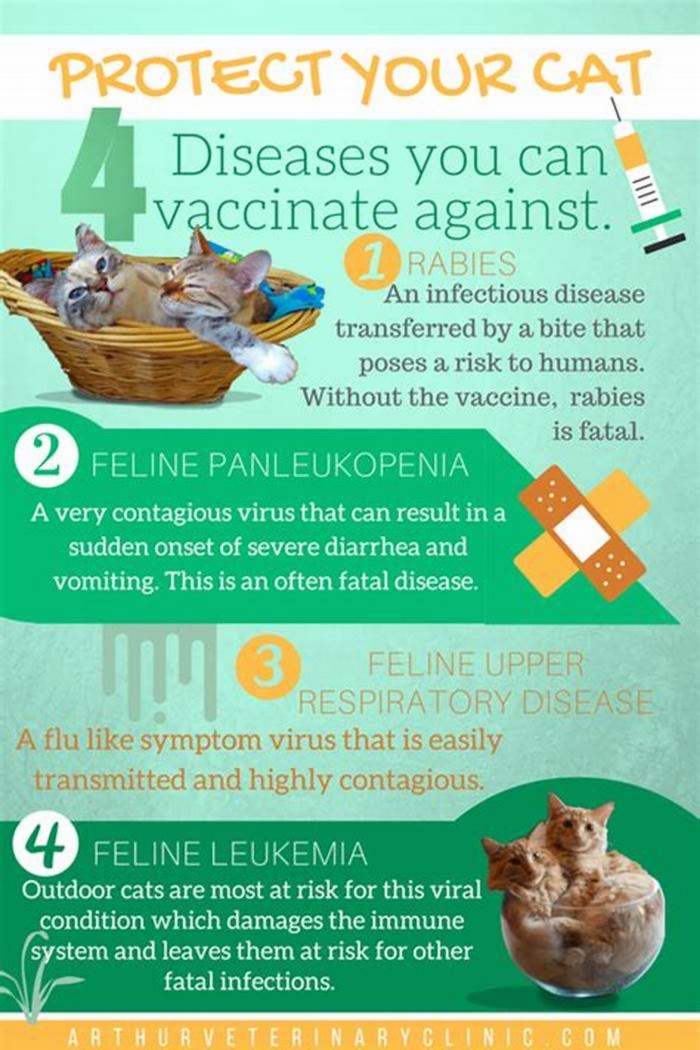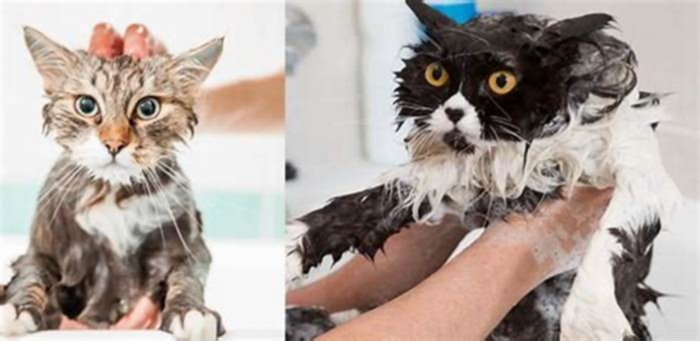What are risk factors for obesity in cats
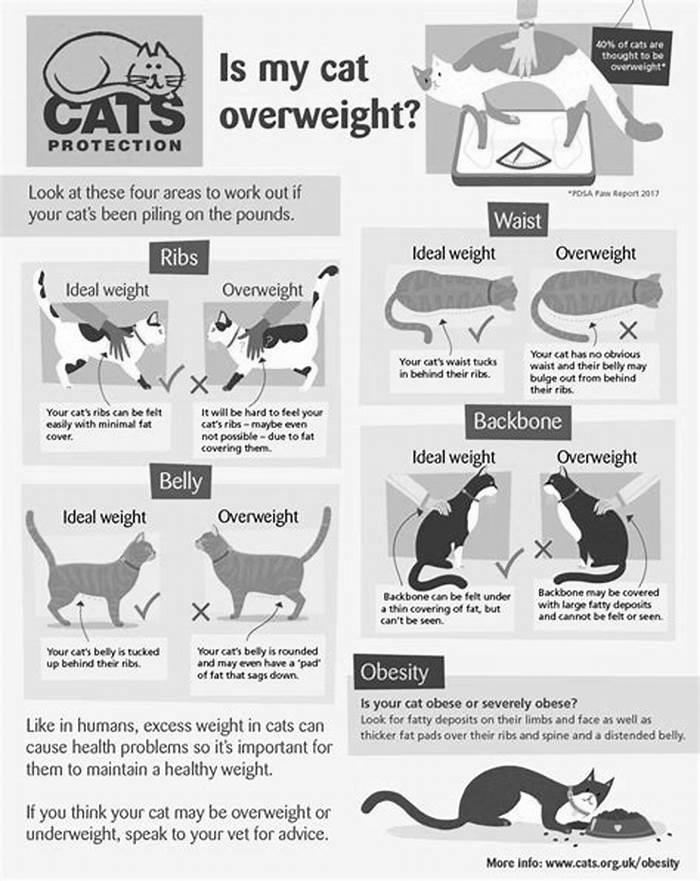
Obesity in Cats
What Is Obesity in Cats?
A cat is considered overweight when it weighs 10-20% more than its ideal body weight, and obese when excess fat is more than 20% above its ideal body weight. Feline obesity is a very common disease, occurring in up to 63% of cats in developed countries.
Being overweight poses significant health risks to your pet, which can include a weakened immune system, endocrine and metabolic disorders, cardiovascular disease, and arthritis. Middle-aged (8-12 years old), neutered, indoor-only or primarily indoor cats tend to be more at risk for becoming obese. Diet and feeding strategies are important for weight management.
Symptoms of Obesity in Cats
Besides visible weight gain, symptoms of obesity include:
Difficulty jumping or climbing stairs
Sitting or lying down more and showing an unwillingness to get up and move around
Loss of a visible waistline
Inability for pet parent to feel rib bones or hip bones
Looking down from above, your cats back appears flat and/or cat profile looks rectangular
Dirty, messy, unkempt hair coat
Collar keeps getting tighter
Less frequent bowel movements and/or more passing of gas
Causes of Obesity in Cats
The reasons for obesity in cats can be broken down into two categories: animal-specific factors and diet-specific factors.
Animal-specific factors
Age: Middle-aged cats 8-12 years old are more likely to be overweight than younger or elderly cats.
Neutered: Male and female neutered cats tend to have a stronger appetite than unneutered cats.
Environment: Indoor cats, or cats with restricted outdoor access, are more commonly overweight because of greater inactivity with fewer opportunities for exercise to burn calories.
Underlying health conditions: Food allergies can make selecting the best kind of food for weight management a challenge. Joint discomfort and arthritis can reduce mobility, and therefore energy use, increasing the risk of weight gain.
Diet-specific factors
Type of diet: Feeding a diet of mostly dry food tends to promote weight gain in cats more so than a diet solely or primarily consisting of canned food.
Inaccurate food measurement: It is important to be consistent with food, and to use a scoop with a known measure (e.g., a -cup measuring cup vs. a plastic cup) and feed out of a bowl size that is appropriate for measured food offered. Without these tools, the risk of over feeding a cat is more likely.
Rapid food consumption: If your pet eats too quickly, this can lead to boredom, crying and begging, which results in feeding your cat more food off schedule to keep him entertained and quiet.
Indulgent feeding practices: Feeding one or two large meals in the day may increase risk of obesity and begging in your cat compared to using free choice feeding or feeding small, frequent meals.
Excessive treats: Treats tend to be higher in fat and calories than a cats regular diet, so offering too many treats throughout the day quickly increases the total calories offered and can create a nutritionally unbalanced diet.
How Vets Diagnose Obesity in Cats
Veterinarians diagnose obesity in cats by assessing body weight in combination with a Body Condition Score chart. All charts use comparable methods of assessment and include instructions to both look at and feel specific places on a cat. The reason body weight alone cannot be used to diagnose obesity is because two cats of the same weight may have very different amounts of fat disposition over their skeleton.
Your vet will use visual assessments and assessments by feel to determine if your cat is obese at its current body weight. Visual assessments include checking for how well ribs and hip bones can be seen. They will determine whether a waistline is visible, and if there are obvious fat deposits under the belly.
Vets will also use their palms to feel over the ribs to determine how well, or how poorly, rib bones can be felt. If a cat is severely obese, the ribs will be difficult to feel under a thick layer of fat, the spine and hip bones will also be covered by fat pads, and the belly will appear distended with no waistline visible.
Vets may diagnose other conditions that are linked to obesity through a physical exam or with bloodwork. These findings may include joint discomfort on manipulation of your cats hips or knees; high blood pressure that shows underlying cardiovascular disease; or high blood glucose suspicious of diabetes.
It is important to allow your veterinarian to do a thorough exam and perform bloodwork as needed to develop an appropriate and safe management strategy for achieving weight loss.
Treatment of Obesity in Cats
It is also important for you to provide your veterinarian with an accurate description of your cats environment and the food provided, including all types of food offered, amounts (by weight or measured scoop), and times fed, so that an appropriate weight loss plan can be developed.
Based on your cats health, your veterinarian will first calculate an appropriate target goal for calories fed per day to promote weight loss and then work with you to employ several strategies to tackle your cats obese condition:
Calorie-restricted foods: Most often a calorie-controlled food will be recommended to promote weight loss but maintain lean muscle mass. Low-carbohydrate and low-fat diets with higher protein and insoluble fiber are generally recommended to promote feeling full.
Dry vs. canned diet: It may be necessary to switch from a dry to a canned diet to best achieve nutrient goals. Remember to never leave moist food out at room temperature for more than 2-4 hours to prevent bacterial growth. Additionally, it is important to thoroughly wash these dishes with warm soapy water between feedings.
Prescription veterinary diets: Metabolic-control prescription veterinary diets may further help to promote weight loss because these diets aim to induce ketosis, where the body burns fat for energy instead of glucose from carbohydrates, rather than a total reduction in calorie intake.
Remember that if you are changing your cats food type, it is important to slowly transition to the new diet over 7-10 days to prevent gastrointestinal upset.
Once a diet is selected, your veterinarian will determine how much food to feed daily based on the caloric goal for weight loss. It is important that you accurately measure how much food is offered per day to meet that caloric goal and stay consistent. Weighing the food on a gram scale is the most accurate means of measurement. Using a specific volume measuring cup is the second-best way to ensure an accurate measure.
You may also want to discuss feeding strategies with your vet to help make the plan successful. Talking points may include:
Bowl selection: Feed in an appropriate, cat-size bowl that appears full or almost full when food is added. Consider puzzle-feeders for those cats who need to be encouraged to slow down when eating.
Timed feeds vs. free choice: Discuss with your veterinarian which feeding strategy might work best for your lifestyle.
When it comes to treats, have a conversation with your veterinarian about the importance of treats in your relationship with your cat. If your favorite part of the day is offering your cat a bedtime snack, it is important for your bond to keep that tradition going. Your veterinarian can work with you to select treats that are lower in fat and higher in fiber and incorporate the treats per day into the goal for total calories.
Work with your veterinarian to be sure they understand your cats particular living situation and can address the weight loss plan from an environmental angle as well. Depending on your cats living situation and underlying health, you and your veterinarian may devise a plan to get your cat moving more. Some examples may include:
Incorporation of puzzle-type feeders to promote more activity during feeds.
If your cat is indoor-only and has limited movement but is otherwise agile and healthy, you can feed several small meals throughout the day on an elevated surface to encourage jumping.
For certain indoor cats who may feel more adventurous, you could fit her with a harness and incorporate a certain number of walks each day.
Recovery and Prevention of Obesity in Cats
Prevention of obesity is key. Understanding the risk factors and working with your veterinarian to manage those can help discourage weight gain early on in your cats life. Once your cat has gained weight and is considered obese, weight management will be a life-long goal.
Once a weight loss plan has been started, it is important to continually monitor your cats progress. It is important that you get a trustworthy scale at home and familiarize yourself with the body condition scales your veterinarian uses. These tools can be used at home to monitor your cats progress.
Because weight management is a long road, it is important to remain patient during this process. Achieving weight loss in your cat can be a life-long process, with few immediate results. Pet parents with more patience tend to have more realistic goals for their cats weight loss over her lifetime, rather than expecting immediate results and abandoning the weight-loss plan when results are not observed.
Additionally, the weight loss plan for your cat will need to be revisited several times throughout your cats life based on age, how successful weight loss is, and whether any other underlying conditions develop, so follow-ups with your veterinarian is essential for success.
Obesity in Cats FAQs
How do I get my indoor cat to lose weight?
The goal for weight loss in cats is to reduce calories and increase energy used. Work with your veterinarian to make sure your cat is on the right diet and being fed the correct number of calories per day for weight loss and try to get your cat moving at home by playing, jumping for meals, or even going on a harness-leash walk. Reduce any potential stressors in households with multiple cats or little kids by giving your cat a quiet place to retreat when needed and consider offering one or all meals in that separate place.
At what point is a cat overweight?
Cats are overweight when they weigh 10-20% more than their expected body weight, where body condition is assessed as ideal. A cat is considered obese when their body weight is more than 20% above their expected body weight.
Does obesity shorten a cats life?
Yes, obesity is a disease that leads to the development of many other diseases that can shorten a cats life, like diabetes, certain types of cancer, metabolic diseases, and respiratory and heart diseases.
References
Wall, Meredith, et al. Owner and Cat-Related Risk Factors for Feline Overweight or Obesity. Frontiers in Veterinary Science, 19 Aug. 2019, www.frontiersin.org/articles/10.3389/fvets.2019.00266/full.
McReynolds, Tony. Pet Obesity Is an Epidemic. American Animal Hospital Association, AAHA, 6 Feb. 2020, http://www.aaha.org/publications/newstat/articles/2020-02/pet-obesity-is-an-epidemic/.
Burkholder WJ, Toll PW. Obesity. In: Hand MS, Thatcher CD, Remillard RL, et al, eds. Small Animal Clinical Nutrition, 4th ed. Topeka, KS: Mark Morris Institute, 2010; 501-544.
WSAVA Global Nutrition Committee. Body Condition Score. World Small Animal Veterinary Association, WSAVA, 13 Aug. 2020, wsava.org/wp-content/uploads/2020/08/Body-Condition-Score-cat-updated-August-2020.pdf.
Cline, Martha G., et al. 2021 AAHA Nutrition and Weight Management Guidelines for Dogs and Cats. Journal of the American Animal Hospital Association, vol. 57, no. 4, 1 July 2021, pp. 153178, 10.5326/jaaha-ms-7232.
Featured Image: iStock.com/Serhii Ivashchuk
Wall, Meredith, et al. Owner and Cat-Related Risk Factors for Feline Overweight or Obesity. Frontiers in Veterinary Science, 19 Aug. 2019, www.frontiersin.org/articles/10.3389/fvets.2019.00266/full.
McReynolds, Tony. Pet Obesity Is an Epidemic. American Animal Hospital Association, AAHA, 6 Feb. 2020, http://www.aaha.org/publications/newstat/articles/2020-02/pet-obesity-is-an-epidemic/.
Burkholder WJ, Toll PW. Obesity. In: Hand MS, Thatcher CD, Remillard RL, et al, eds. Small Animal Clinical Nutrition, 4th ed. Topeka, KS: Mark Morris Institute, 2010; 501-544.
WSAVA Global Nutrition Committee. Body Condition Score. World Small Animal Veterinary Association, WSAVA, 13 Aug. 2020, wsava.org/wp-content/uploads/2020/08/Body-Condition-Score-cat-updated-August-2020.pdf.
Cline, Martha G., et al. 2021 AAHA Nutrition and Weight Management Guidelines for Dogs and Cats. Journal of the American Animal Hospital Association, vol. 57, no. 4, 1 July 2021, pp. 153178, 10.5326/jaaha-ms-7232.
Featured Image: iStock.com/Serhii Ivashchuk
WRITTEN BY
Amanda Ardente, DVM, PhDVeterinarian
Dr. Amanda Ardente founded Ardente Veterinary Nutrition LLC in August 2017, based on a long-term goal of combining her passion for...

